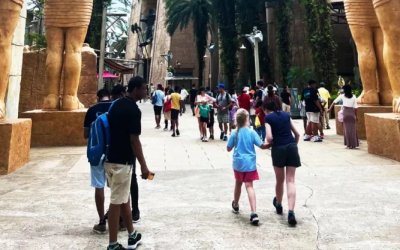距离AEIS开考
还剩19天!
进入最后冲刺阶段!
2019年的AEIS考试时间
新加坡教育部(MOE)官网正式对外公布2019年AEIS考试定于2019年9月17日、18日和19日举行,报名时间将于7月开始,教育部也将于7月公布更多报名及考试详情。

时间越来越紧迫了
小伙伴们语法都掌握了吗
一起来复习一下吧
there be+宾语+现在分词。现在分词表示主动关系,同时表示动作正在进行:
There is someone waiting for him.
有人在等他。
There was a man standing in front of me.
我前面站着一个男人。
There were some children swimming in the river.
有些小孩在河里游泳。
There were a group of young people working in the fields.
有一群青年在地里劳动。
有时现在分词可表示一种状态:
There’s a piano standing against the wall.
靠墙有一架钢琴。
There’re a lot of difficulties facing us.
我们面前有很多困难。
There is a door leading to the garden.
有一座门通往花园。
有个别现在分词用于该结构时可以表示将来(正如它们可用进行时表示将来一样):
There are ten people coming to dinner.
有10个人来吃晚饭。
there be+宾语+过去分词。过去分词表示一种被动关系,同时表示动作已经发生:
There were ten people killed in the accident.
事故中有10人丧生。
有时过去分词也可表示一种状态(可转换成被动结构):
There were some old men seated (=who were seated) in the back.
有些老人坐在后面。
There is a red car parked (=which is parked) outside the house.
房子外边停著一辆红色汽车。

there be+宾语+不定式。不定式通常表示动作尚未发生:
There was nobody to look after the child.
没有人照顾这孩子。
There was a large crowd to send him off.
有一大群人要来给他送行。
There was so much to lose that we couldn’t take any risks. 可能会有很大的损失,因此我们不能冒险。
【注】当其中的宾语与其后的不定式为被动关系时,可用主动表被动,也可用被动式:
There is much work to do [to be done].
有许多工作要做。
有时其中的不定式为系表结构:
There is nothing to be afraid of.
没什么可怕的。
What was there to be afraid of.
有什么可怕的?
There’s nothing to be ashamed of.
没有什么值得羞愧的。

接着来复习一下吧

(1)有一些动词是瞬间动词,也叫非延续性动词,这些动词一发生就结束了,常见的有:
come, go, arrive, reach, leave, begin, start, buy, join, die, borrow, get up, become, open, stop等。
这些动词虽然可以用于现在完成时(说明某个动作的结果还存在),但由于它们不能延续,因此不能跟表示一段的时间状语连用。(也即现在完成时的第二个基本用法中不能使用非延续性动词)。
e.g. Jim has come back. (正) 吉姆已经回来了。
Jim has come back for a month. (误) come back的动作不能延续一个月,因此错误。
(2)瞬间动词不可以用于有段时间的现在完成时态中,因此,若要解决这一问题,就应把它改为相应的延续性动词或短语,主要有以下几种:
用相应的延续性动词
如:buy have borrow keep come/go/become be put>
如:join be a member of go to school be a student 转换成be+形容词或副词
如:die be dead leave be away begin be> 如:come to/go to/arrive in (at)/get to/reach … be in/at… join the army be in the army(军队)
e.g. I have borrowed the book.
我已经借了那本书。
I have kept the book for two days.
我已经借那本书两天了。
Jim has joined the band.
吉姆已经加入那乐队了。
Jim has been a member of the band for a month.
吉姆已经加入那个乐队一个月了。
His grandfather has died.
他祖父已经死了。
His grandfather has been dead for 2 years. 、
他祖父已经死了两年了。
My father has arrived in China.
我父亲已经到达中国了。
My father has been in China for a week.
我父亲已经在中国一个星期了。
(3)在否定句中,非延续性动词也可以与时间段连用。
e.g. I haven’t borrowed books from the library since last year.
自去年以来我就没有在图书馆借过书。
Jim hasn’t come back for a year.
吉姆已有一年没回来了。

还有遗漏的吗

1
句式结构
英语句子根据句式复杂程度分为3种:简单句、复合句和主从句。其中最重要的是主从句!
要想把两个和两个以上的句子连成一个句子,我们需要并列连词和主从连词。
这些连词被我们用在并列句和主从句中,主从句分为三大类:
名词性从句,定语从句和同位语从句。
如果我们可以记住一些常用短语搭配,特别是动词搭配,那么我们就可以避免一些句式结构方面的错误,我们来聚焦下一个重要语法问题。
2
动词短语的常见搭配
如果我们想把两个动词连在一起,那么后面一个动词要变成它的非谓语形式。
前面一个动词做句子的谓语,谓语动词我们要注意时态和语态两个方面。
英语中的时态分为16种;英语中的语态分为主动语态和被动语态两种。虽然我们的语态只有两类,但是在平时英语学习中,我们很多同学都缺乏被动语态的意识,从来不考虑语态问题。
我们大家需要把语态也提升到和时态同样的高度。
谓语动词后面接的动词到底用非谓语的那种形式需要我们平时的积累。

到底是加上“do/to do”还是“doing”?
从分类上来说这三种形式分为两类:do/to do和doing. 前面的do 为省略to 的不定式。省略的to 在变成被动语态时要还原。下面我们来总结一下动词短语的常见搭配:
1.接不定式(而不接动名词)作宾语的常用动词:
afford to do sth. 负担得起做某事
agree to do sth. 同意做某事
arrange to do sth. 安排做某事
2.接不定式作宾补的常用动词:
advise sb. to do sth. 建议某人做某事
allow sb. to do sth. 允许某人做某事
ask sb. to do sth. 请(叫)某人做某事
3.接动名词(不接不定式)作宾语的常用动词:
admit doing sth. 承认做某事
advise doing sth. 建议做某事
allow doing sth. 允许做某事
4.接现在分词作宾补的常用动词:
bring sb. doing sth. 引起某人做某事
catch sb. doing sth. 碰上(撞上)某人做某事
discover sb. doing sth. 发现某人做某事
5.接动词原形作宾补的常用动词:
feel sb. do sth. 感觉某人做某事
have sb. do sth. 使某人做某事
hear sb. do sth. 听见某人做某事
6.接不定式或动名词作宾语意思相同的动词:
like to do sth / like doing sth. 喜欢做某事
love to do sth / love doing sth. 喜欢做某事
hate to do sth / hate doing sth. 憎恨做某事
7.接不定式或动名词作宾语意思不同的动词:
(1) remember to do sth. 记住要做某事
remember doing sth. 记住曾做过某事
(2) forget to do sth. 忘记要做某事
forget doing sth. 忘记曾做过某事























